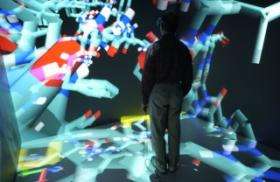Virtual Reality Becoming a Valuable Resource for Researchers

Virtual reality isn’t just for gamers anymore. At the University of Arizona, the technology that used to be synonymous with the video game industry is now supporting the efforts of UA researchers in fields as diverse as medicine, educational psychology and landscape architecture.
David Soren, Regents professor of classics at the UA, is working with information technology professionals from the Arizona Laboratory for Immersive Visualization Environments (AZ-LIVE) to design the first interactive reconstruction of the ancient Italian archeological site of Chianciano Terme.
AZ-LIVE is an on-campus facility where university researchers, faculty and students can be immersed in a three-dimensional, computer-generated world. The environment combines 3D computer graphics, stereoscopic projection and viewing technology, acoustical six-dimensional tracking devices and four-channel audio to create the illusion of being present in a virtual world.
The reconfigurable projection walls allow users to view their virtual worlds in an intimate cave-like enclosure, a slightly larger immersive theater or a very large flat vertical display. The advanced projection and tracking system, along with the computing technology in AZ-LIVE, combine to create an environment in which a wide range of applications, models and virtual worlds can be displayed and navigated interactively.
“This immersive, three-dimensional environment is bringing together research, instruction and technology, said Marvin Landis, scientific visualization specialist and AZ-LIVE coordinator. “AZ-LIVE takes what you used to have to view on a computer screen or a model and instead places you inside that environment, from an ancient Italian village to the human heart.”
Landis estimates that fewer than 20 universities in the United States have immersive visualization facilities as comprehensive as AZ-LIVE. According to Landis, researchers in art, medicine, civil and industrial engineering, chemistry, architecture and landscape architecture, educational psychology and atmospheric sciences are all incorporating virtual reality models into their research.
The most commonly used configuration of AZ-LIVE features projections on three walls and on the floor, which is the one used to experience Soren’s archeological reconstruction.
Soren and other UA researchers initiated excavation of an archaeological zone in a region of central Chianciano, known as Mezzomiglio, in 1995, gradually revealing the largest man-made cold water spa in all of ancient Italy and springs once used by the emperor Augustus.
Soren believes the virtual reconstruction of Chianciano Terme will be the closest thing to actually being there. “You will be able to put yourself in the ancient site,” said Soren. “You’ll even be able to see and hear the ripples of Chianciano’s legendary baths.”
Source: University of Arizona





















